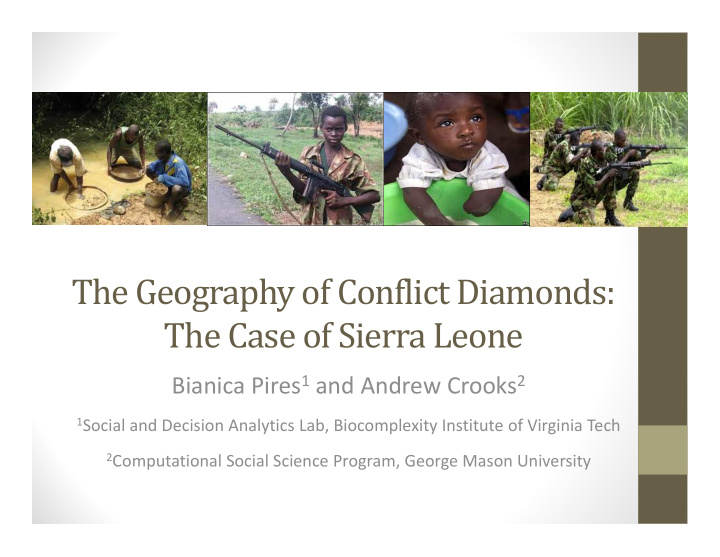



The Geography of Conflict Diamonds: The Case of Sierra Leone Bianica Pires 1 and Andrew Crooks 2 1 Social and Decision Analytics Lab, Biocomplexity Institute of Virginia Tech 2 Computational Social Science Program, George Mason University
Background • Sierra Leone entered into nearly 10 years of civil war in 1991 • Killed an estimated 70,000 and displaced another 2.6 million • Endowed with an abundance of diamond resources • An ABM is developed to explore the role of geography in a resource- driven war
The Model • An ABM is integrated with GIS to explore Le Billon’s (2001) theory about the spatial dispersion of a resource Concentration / Relation Diffuse Point to Center Distant Warlordism Secession Proximate Mass rebellion / rioting State control or coup • Modeling world is the country of Sierra Leone • Broken down into one km 2 parcels • Total population is 4.9 million • Population within each parcel was reclassified to 1% of total population • The agents represent individual residents • Attributes include age, income level, and employment status
Agent Behavior Set of possible motives Set of possible actions (1) Need for basic necessities, (1) Rebel such as food, water, and shelter (2) Get employment as Diamond Miner (2) Need for security of Intensity employment, shelter, and Analyzer (3) Remain employed with resources Other Employers (3) Need to maintain household (4) Stay home • The PECS framework is used to implement agent behavior • Intensity analyzer is responsible for determining the action-guiding motive
Agent Behavior Input Percep on Sensor Social Status Cogni on Emo on Physis Transi on Processes State Variables & Social Role and Informa on about Individual Group Iden ty Environment within Characteris cs Vision Ac on Sequence Legend Needs Model Opportunity Model Iden ty Model Output Behavior Actor The Opportunity Model The Needs Model The Identity Model (Maslow, 1954) (Fearon and Laitin, 2003; Le (Stets and Burke, 2000) Billon, 2005; Lujala et al, 2005)
MOVIE
Qualitative Agreement of Model Results
The Impact of the Spatial Dispersion of a Resource • Experiments were performed seeking to replicate Le Billon’s (2001) theory about the spatial dispersion of resources and its impact on the type of conflict The relationship between the spatial dispersion of a resource and conflict type. Concentration / Relation Diffuse Point to Center Distant Warlordism Secession Proximate Mass rebellion / rioting State control or coup Experiment specifications Experiment Parameter Range Location of Diamond Mines Distant Government Control [0, 1] Actual Proximate Government Control [0, 1] Freetown
Results – Distant Resources • No government control • Widespread conflict emerged spatially similar to the actual situation of Sierra Leone • Spatial dispersion seems to support warlordism • Increasing government control • Displaces the conflict • Conflict is contained to the periphery of the country • Spatial dispersion looks to support succession Secession Warlordism
Results – Proximate Resources • When the resource moves to the city so does the violence • Conflict is contained, even with no government control • Minimal control is sufficient to prevent rebellion • Difficulty in supporting the case of state coup Mass rebellion State coup
Summary • Through the integration of ABM and GIS, the model explores Le Billon’s theory and the impact that the unique socioeconomic attributes of a region and its population can have on the onset of conflict • Spatial dynamics were observed as diamond mines were made more secure and moved near city centers • Model results support Le Billon’s argument for distant resources • Warlordism is associated with diffuse and distant resources • Secession is associated with point and distant resources • Model results do not support or reject the argument for proximate resources • When an environment is ripe for conflict, this type of model could potentially provide insights into the locations most prone to conflict and the characteristics of the conflict
The Agent ‐ Based Model Figure 5‐4. Flow diagram of key processes.
Recommend
More recommend